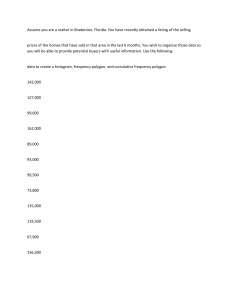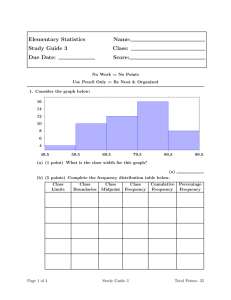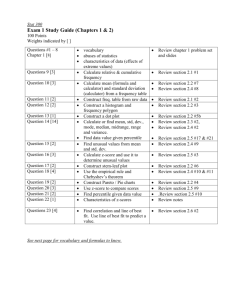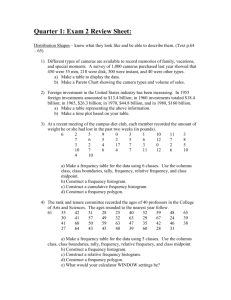DATA ANALYSIS (with GRAPHS)
advertisement
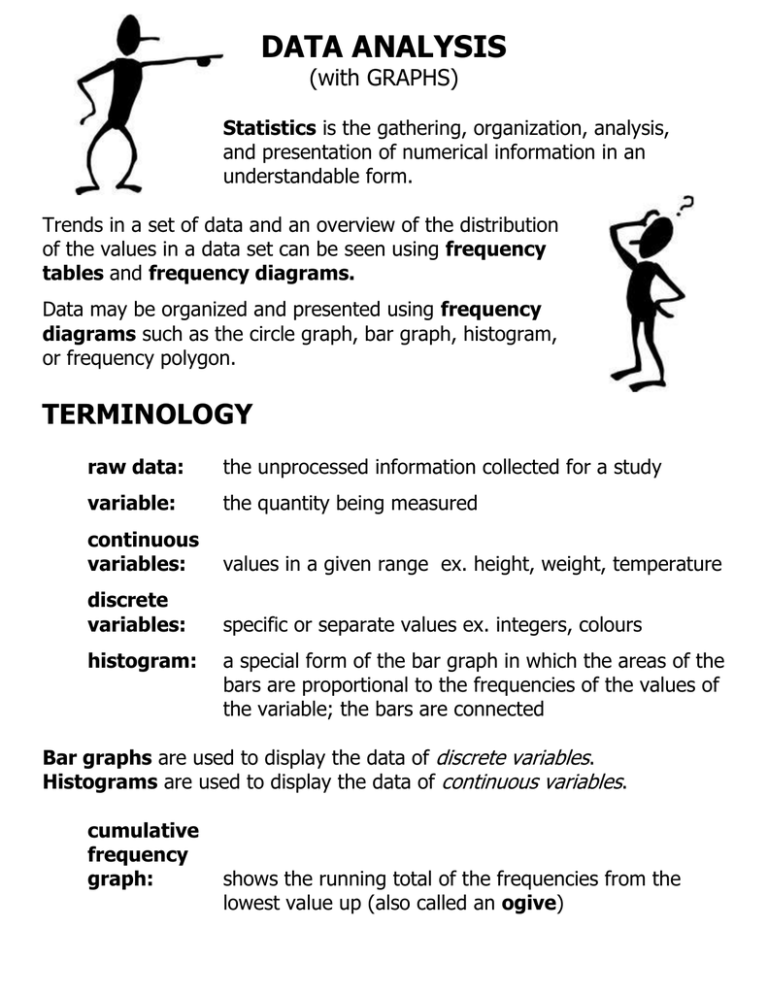
DATA ANALYSIS (with GRAPHS) Statistics is the gathering, organization, analysis, and presentation of numerical information in an understandable form. Trends in a set of data and an overview of the distribution of the values in a data set can be seen using frequency tables and frequency diagrams. Data may be organized and presented using frequency diagrams such as the circle graph, bar graph, histogram, or frequency polygon. TERMINOLOGY raw data: the unprocessed information collected for a study variable: the quantity being measured continuous variables: values in a given range ex. height, weight, temperature discrete variables: specific or separate values ex. integers, colours histogram: a special form of the bar graph in which the areas of the bars are proportional to the frequencies of the values of the variable; the bars are connected Bar graphs are used to display the data of discrete variables. Histograms are used to display the data of continuous variables. cumulative frequency graph: shows the running total of the frequencies from the lowest value up (also called an ogive) FREQUENCY GRAPHS (Examples) HISTOGRAM (continuous variables) BAR GRAPH (discrete variables) FREQUENCY POLYGON CUMULATIVE-FREQUENCY GRAPH Example 174 177 166 159 The heights of the girls in a physical education class, measured to the nearest centimetre, are given below: 175 185 190 173 180 193 172 181 182 170 184 184 153 163 157 163 161 187 178 170 165 171 152 167 a) Use a frequency table to organize this data. NOTE: heights range from shortest ________ to tallest ________ Height Intervals 150 160 170 180 190 – – – – – 159 169 179 189 199 Tallies Frequency cm cm cm cm cm b) Describe any trends apparent from the organization of the data in the above table. c) Use a graph to display the information in the frequency table. NOTE: continuous variable – use a histogram GIRL’S PHYS. ED CLASS HEIGHTS FREQUENCY 11 10 9 8 7 6 5 4 3 2 1 - ‘ 140 ‘ 150 ‘ 160 ‘ 170 ‘ 180 ‘ 190 ‘ 200 ‘ 210 HEIGHT (cm) The frequency polygon can be superimposed onto the histogram. d) Create a cumulative frequency column on the frequency table and produce a cumulative frequency polygon. Height Intervals 150 160 170 180 190 – – – – – 159 169 179 189 199 Frequency Cumulative Frequency cm cm cm cm cm Recall…cumulative frequency is a “running total”. GIRL’S PHYS. ED CLASS HEIGHTS 30 25 CUMULATIVE FREQUENCY 20 15 10 5 ‘ 140 ‘ 150 ‘ 160 ‘ 170 ‘ 180 ‘ 190 ‘ 200 ‘ 210 HEIGHT (cm) How many girls have a height of 179 cm or less? ____________ e) Create a relative frequency column on the frequency table and produce a relative frequency polygon. Height Intervals Frequency Relative Frequency 150 – 159 cm 160 – 169 cm 170 – 179 cm 180 – 189 cm 190 – 199 cm TOTAL: NOTE: relative frequency = frequency total Relative frequency shows the frequency of a data group as a fraction or percent of the whole group. GIRL’S PHYS. ED CLASS HEIGHTS 0.4 - RELATIVE FREQUENCY 0.3 0.2 0.1 ‘ 140 ‘ 150 ‘ 160 ‘ 170 ‘ 180 ‘ 190 ‘ 200 ‘ 210 HEIGHT (cm) How does the relative frequency polygon compare to the frequency polygon? ______________________________________________

